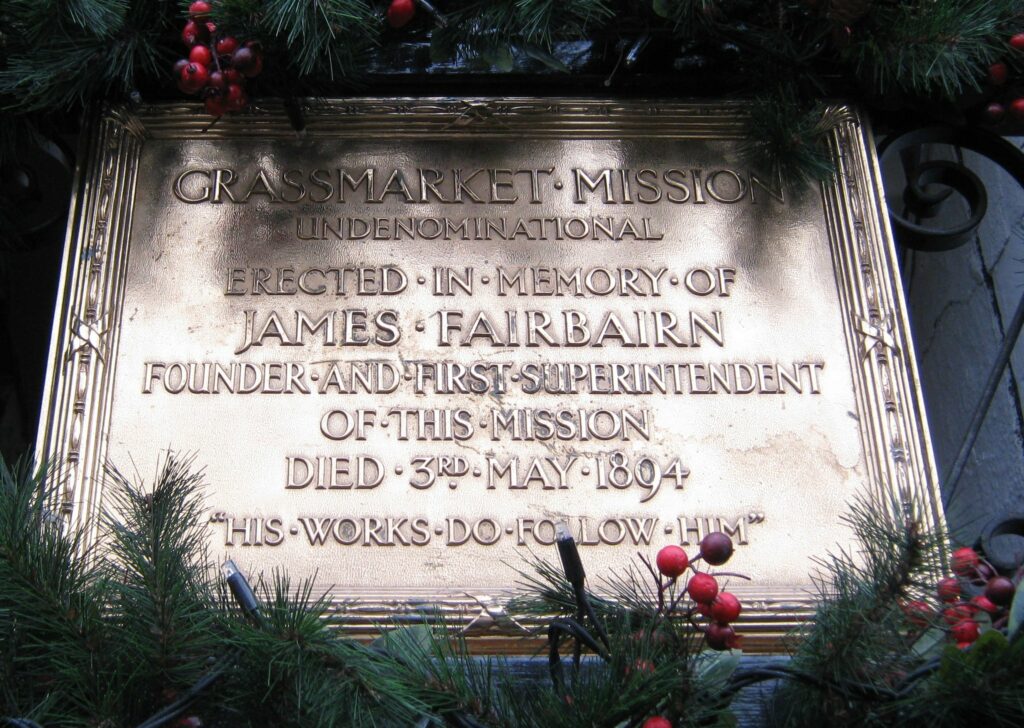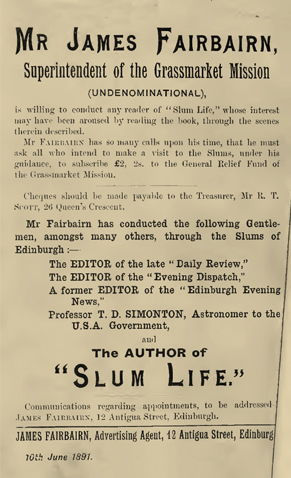The Grassmarket Mission was founded by James Fairbairn in 1886. With the financial support of Mrs Jane Buchanan, he purchased the site and commissioned James Lessels to build, in 1890, the Mission Hall at 94 Grassmarket. That same year the Mission was registered as a charitable Trust with Fairbairn as one of the eight Trustees and Superintendent to the Mission. Fairbairn died in 1894 and there is a plaque in his memory in the Grassmarket.

When the Grassmarket Mission was established, the Grassmarket area and neighbouring Cowgate was a slum, with chronic overcrowding, sub-standard housing, poverty, unemployment, disease and crime. The living conditions were foul, with sometimes as many as eight people occupying a single room. This overcrowding was made worse by the practice of taking in lodgers, necessary to enhance meagre incomes. Most dwellings has no sanitation or running water.

City of Edinburgh Council – Edinburgh Libraries, www.capitalcollections.org.uk
A contemporary account from “Slum Life in Edinburgh“, published by James Thin in 1891, describes the squalor and deprivation endured by the hundreds of people in the poor quarters of the town. Many of the poor turned to drink to try to escape the harsh realities of their existence and environment and it was the families with children, who had nothing and whose parents who could afford nothing, as well as the homeless that the Mission sought to help.
The Mission provided food and clothing as well as fellowship through the meetings and services held there. Fairbairn would organise talks, given by some of Edinburgh’s most prominent citizens, which would attract donations to the work of the Mission, testament perhaps to his skill as an advertising agent.

In 1930, the Mission purchased the building next door (at 96 Grassmarket) and constructed a new Mission Hall with an up-to-date kitchen, a clothing department and flats upstairs, which was officially opened in November that year – no mean feat in the depression era. The extra space meant that the Mission was able to expand the services that it was providing. Under the stewardship of Alexander Barrie, who was appointed Superintendent in 1916, the Mission was built up “into an organisation unimagined by his predecessors” to the extent that the Mission became known colloquially as “the Barries”. At one time up to 1,500 children are said to have assembled in the Grassmarket, accompanied by 200 adult volunteers, to take the tram out to Gorgie terminus for a picnic in a field at Stenhouse Mills.

City of Edinburgh Council – Edinburgh Libraries, www.capitalcollections.org.uk
In 1933 the Mission purchased a large house in Aberlady called the Poplars where the people of the Grassmarket could go “for a fortnight’s rest, recreation and good example.” These were, it seems, golden times for the work of the Mission though the plight of the poor in the Grassmarket remained.
After the second world war, gradually, many of the missions and other charitable organisations closed their doors. With the growth of the welfare state, the worst excesses of deprivation had been reduced, the government and local authorities were providing greater support, and the numbers of people living in the Grassmarket were falling. Families had been moved out to the council estates being built around the city suburbs, and improvements made to the built environment meaning that the Mission ministered to dwindling numbers. As it reached its centenary in 1986 the worsening financial situation at the Mission was never far from the minds of its Trustees. As they were underused and increasingly expensive to maintain, in 1989 the decision was made to sell the Mission Halls.
Meanwhile, in Aberlady, the future of Poplars was precarious. Not for many years had it fulfilled its role as a holiday home for Grassmarket residents. Essentially being used as a care home for the elderly, it had been running into difficulties financially, but with increased costs to comply with new legislation, staffing and upkeep of the building, in 2000 the Trustees decided to close the home and sell the buildings.
The Grassmarket Mission now concentrated its efforts and financial support on the work of the students of New College who had been offered the use of the Greyfriars Kirkhouse by the church as a base for Christian outreach and work with the homeless. This support included assisting the development of the services provided in the Greyfriars Kirkhouse and its community outreach programme, the Community Project, which included cookery classes, the GRoW project (creating quality products from recycled wood), CLOOT (Textile Social Enterprise) and the herb garden alongside its canteen provision – all provided in line with the Mission’s aims.
Agreement was reached with Greyfriars Kirk on the future of the Community Project and development of the Kirkhouse as the base for the outreach work of both the Mission and Greyfriars Kirk and in July 2010 the new independent charity, the Grassmarket Community Project, was incorporated. Following the sale of all its property by 2011, the Mission agreed to substantially assist financially with the Kirkhouse development capital building works as well as contributing funding towards the ongoing outreach activities for a period of two years, which now included the employment of a full-time fieldworker and assistant, a cookery co-ordinator and a caretaker.
Today the Mission continues as an independent charity and its principal charitable activity has continued to be the support of the Grassmarket Community Project. The Trustees believe that this funding has provided one of the best ways to meet its aims of addressing social exclusion caused by poverty, hunger, loneliness and homelessness as well as vulnerability through substance abuse or ill-health. GCP is well placed to meet and adapt to the needs of people in the rapidly changing environment of the Grassmarket and the wider community. The Trustees also maintain their intention of supporting other local charities whose objectives align with those of the Mission. The Mission had its roots in the social concern of James Fairbairn and the original Trustees who founded the Grassmarket Mission in 1886 for the relief of those who were in serious need, mainly through homelessness and hunger. This has developed to encompass a wider definition of community and through GCP and other grants, the Mission aims to assist people dealing with a wide range of complex issues including mental and physical problems, poverty, substance misuse, social isolation and more.
A fuller account of the history of the Grassmarket Mission can be found in Professor Alan Harding’s book “Ministering to the Poor in Victorian Edinburgh and The History of the Grassmarket Mission” which itself draws heavily on an earlier booklet “The Story of the Grassmarket Mission 1886-1961 – The Arches of the Years” published in 1961 which chronicles the first 75 years of the Mission.
More information about the fascinating history of the Grassmarket can be found here.
